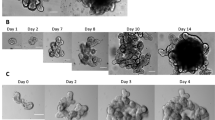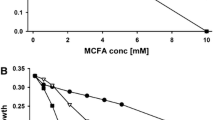Abstract
In vitro studies on the pathogenesis in swine have been hampered by the lack of relevant porcine cell lines. Since many bacterial infections are swine-specific, studies on pathogenic mechanisms require appropriate cell lines of porcine origin. We have characterized the permanent porcine intestinal epithelial cell line, IPEC-J2, using a variety of methods in order to assess the usefulness of this cell line as an in vitro infection model. Electron microscopic analyses and histochemical staining revealed the cells to be enterocyte-like with microvilli, tight junctions and glycocalyx-bound mucin. The functional integrity of monolayers was determined by transepithelial electrical resistance (TEER) measurements. Both commensal bacteria and important bacterial pathogens were chosen for study based on their principally different infection mechanisms: obligate extracellular Escherichia coli, facultative intracellular Salmonella and obligate intracellular Chlamydia. We determined the colonization and proliferation of the bacteria on and within the host cells and monitored the host cell response. We verified the expression of mRNAs encoding the cytokines IL-1α, −6, −7, −8, −18, TNF-α and GM-CSF, but not TGF-β or MCP-1. IL-8 protein expression was enhanced by Salmonella invasion. We conclude that the IPEC-J2 cell line provides a relevant in vitro model system for porcine intestinal pathogen–host cell interactions.











Similar content being viewed by others
Abbreviations
- AE:
-
Attaching and effacing
- CLSM:
-
Confocal laser scanning microscopy
- DAPI:
-
4′,6-Diamidino-2-phenylindole
- DMEM:
-
Dulbecco’s modified eagle medium
- EGF:
-
Epidermal growth factor
- EPEC:
-
Enteropathogenic E. coli
- FCS:
-
Fetal calf serum
- FITC:
-
Fluoresceinisothiocyanate
- GFP:
-
Green fluorescent protein
- GM-CSF:
-
Granulocyte macrophage colony stimulating factor
- IFN:
-
Interferon
- ITS:
-
Insulin transferrin selenium
- MOI:
-
Multiplicity of infection
- PAS:
-
Periodic acid-Schiff reaction
- PBS:
-
Phosphate buffered saline
- RT:
-
Reverse transcriptase
- TEER:
-
Transepithelial electrical resistance
- TNF:
-
Tumor necrosis factor
References
Abreu MT, Fukata M, Arditi M (2005) TLR signaling in the gut in health and disease. J Immunol 174:4453–4460
Batchelor M, Guignot J, Patel A, Cummings N, Cleary J, Knutton S, Holden DW, Connerton I, Frankel G (2004) Involvement of the intermediate filament protein cytokeratin-18 in actin pedestal formation during EPEC infection. EMBO Rep 5:104–110
Baumler AJ, Tsolis RM, Ficht TA, Adams LG (1998) Evolution of host adaptation in Salmonella enterica. Infect Immun 66:4579–4587
Bavoil PM, Hsia R, Ojcius DM (2000) Closing in on Chlamydia and its intracellular bag of tricks. Microbiology 146 (Pt 11):2723–2731
Blaser MJ (1997) Epidemiologic and clinical features of Campylobacter jejuni infections. J Infect Dis 176(Suppl 2):103–105
Carlson SA, Omary MB, Jones BD (2002) Identification of cytokeratins as accessory mediators of Salmonella entry into eukaryotic cells. Life Sci 70:1415–1426
Chang SK, Dohrman AF, Basbaum CB, Ho SB, Tsuda T, Toribara NW, Gum JR, Kim YS (1994) Localization of mucin (MUC2 and MUC3) messenger RNA and peptide expression in human normal intestine and colon cancer. Gastroenterology 107:28–36
Claud EC, Savidge T, Walker WA (2003) Modulation of human intestinal epithelial cell IL-8 secretion by human milk factors. Pediatr Res 53:419–425
Darwin KH, Miller VL (1999) Molecular basis of the interaction of Salmonella with the intestinal mucosa. Clin Microbiol Rev 12:405–428
Dozois CM, Oswald E, Gautier N, Serthelon JP, Fairbrother JM, Oswald IP (1997) A reverse transcription-polymerase chain reaction method to analyze porcine cytokine gene expression. Vet Immunol Immunopathol 58:287–300
Dvorak P, Hruban V, Horak V (1987) The distribution of class II molecules in the pig intestine. Folia Morphol (Praha) 35:396–399
Eckmann L, Jung HC, Schurer-Maly C, Panja A, Morzycka-Wroblewska E, Kagnoff MF (1993) Differential cytokine expression by human intestinal epithelial cell lines: regulated expression of interleukin 8. Gastroenterology 105:1689–1697
Egan LJ, de Lecea A, Lehrman ED, Myhre GM, Eckmann L, Kagnoff MF (2003) Nuclear factor-kappa B activation promotes restitution of wounded intestinal epithelial monolayers. Am J Physiol Cell Physiol 285:C1028–C1035
Fromter E, Diamond J (1972) Route of passive ion permeation in epithelia. Nat New Biol 235:9–13
Gebert A, Rothkotter HJ, Pabst R (1994) Cytokeratin 18 is an M-cell marker in porcine Peyer’s patches. Cell Tissue Res 276:213–221
Kaeffer B, Bottreau E, Velge P, Pardon P (1993) Epithelioid and fibroblastic cell lines derived from the ileum of an adult histocompatible miniature boar (d/d haplotype) and immortalized by SV40 plasmid. Eur J Cell Biol 62:152–162
Lee CA, Falkow S (1990) The ability of Salmonella to enter mammalian cells is affected by bacterial growth state. Proc Natl Acad Sci USA 87:4304–4308
Martinez-Lorenzo MJ, Meresse S, de Chastellier C, Gorvel JP (2001) Unusual intracellular trafficking of Salmonella typhimurium in human melanoma cells. Cell Microbiol 3:407–416
McCormick BA, Colgan SP, Delp-Archer C, Miller SI, Madara JL (1993) Salmonella typhimurium attachment to human intestinal epithelial monolayers: transcellular signalling to subepithelial neutrophils. J Cell Biol 123:895–907
McOrist S, Jasni S, Mackie RA, Berschneider HM, Rowland AC, Lawson GH (1995) Entry of the bacterium ileal symbiont intracellularis into cultured enterocytes and its subsequent release. Res Vet Sci 59:255–260
Moncada DM, Kammanadiminti SJ, Chadee K (2003) Mucin and toll-like receptors in host defense against intestinal parasites. Trends Parasitol 19:305–311
Nataro JP, Kaper JB (1998) Diarrheagenic Escherichia coli. Clin Microbiol Rev 11:142–201
Oppenheim JM, Feldmann M (2001) Cytokine reference. Academic, New York
Pitman RS, Blumberg RS (2000) First line of defense: the role of the intestinal epithelium as an active component of the mucosal immune system. J Gastroenterol 35:805–814
Rahner C, Mitic LL, Anderson JM (2001) Heterogeneity in expression and subcellular localization of claudins 2, 3, 4, and 5 in the rat liver, pancreas, and gut. Gastroenterology 120:411–22
Rescigno M, Urbano M, Valzasina B, Francolini M, Rotta G, Bonasio R, Granucci F, Kraehenbuhl JP, Ricciardi-Castagnoli P (2001) Dendritic cells express tight junction proteins and penetrate gut epithelial monolayers to sample bacteria. Nat Immunol 2:361–367
Sanchez C, Domenech N, Vazquez J, Alonso F, Ezquerra A, Dominguez J (1999) The porcine 2A10 antigen is homologous to human CD163 and related to macrophage differentiation. J Immunol 162:5230–5237
Simon DB, Lu Y, Choate KA, Velazquez H, Al-Sabban E, Praga M, Casari G, Bettinelli A, Colussi G, Rodriguez-Soriano J, McCredie D, Milford D, Sanjad S, Lifton RP (1999) Paracellin-1, a renal tight junction protein required for paracellular Mg2+ resorption. Science 285:103–106
Solano-Aguilar GI, Vengroski KG, Beshah E, Lunney JK (2000) Isolation and purification of lymphocyte subsets from gut-associated lymphoid tissue in neonatal swine. J Immunol Methods 241:185–199
Sonntag AK, Bielaszewska M, Mellmann A, Dierksen N, Schierack P, Wieler LH, Schmidt MA, Karch H (2005) Shiga toxin 2e-producing Escherichia coli from humans and pigs differ by their virulence profiles and interaction with intestinal epithelial cells (accepted)
Suchland RJ, Geisler WM, Stamm WE (2003) Methodologies and cell lines used for antimicrobial susceptibility testing of Chlamydia spp. Antimicrob Agents Chemother 47:636–642
Sun J, Hobert ME, Duan Y, Rao AS, He TC, Chang EB, Madara JL (2005) Crosstalk between NF-kappaB and beta-catenin pathways in bacterial-colonized intestinal epithelial cells. Am J Physiol Gastrointest Liver Physiol 289:G129-G137
Terano A, Sakata-Horie K, Shimada T, Hiraishi H, Yoshiura K, Yoneda M, Takahashi M, Fujimori T (2001) The role of cellular migration in the repair process of gastric epithelial cells. Life Sci 69:3083–3089
Terres AM, Windle HJ, Ardini E, Kelleher DP (2003) Soluble extracts from Helicobacter pylori induce dome formation in polarized intestinal epithelial monolayers in a laminin-dependent manner. Infect Immun 71:4067–4078
Vazquez-Torres A, Jones-Carson J, Baumler AJ, Falkow S, Valdivia R, Brown W, Le M, Berggren R, Parks WT, Fang FC (1999) Extraintestinal dissemination of Salmonella by CD18-expressing phagocytes. Nature 401:804–808
Weng XH, Beyenbach KW, Quaroni A (2005) Cultured monolayers of the dog jejunum with the structural and functional properties resembling the normal epithelium. Am J Physiol Gastrointest Liver Physiol 288:G705–G717
Weyrauch KD (1983) The conjunctival epithelium in domestic ruminants. II. Electronmicroscopic investigations. Z Mikrosk Anat Forsch 97:573–588
Wieler LH, Ilieff A, Herbst W, Bauer C, Vieler E, Bauerfeind R, Failing K, Klos H, Wengert D, Baljer G, Zahner H (2001) Prevalence of enteropathogens in suckling and weaned piglets with diarrhoea in southern Germany. J Vet Med B Infect Dis Vet Public Health 48:151–159
Wilcox ER, Burton QL, Naz S, Riazuddin S, Smith TN, Ploplis B, Belyantseva I, Ben-Yosef T, Liburd NA, Morell RJ, Kachar B, Wu DK, Griffith AJ, Friedman TB (2001) Mutations in the gene encoding tight junction claudin-14 cause autosomal recessive deafness DFNB29. Cell 104:165–172
Acknowledgements
We thank H. Steinrück (Bundesinstitut für Risikobewertung, Berlin, Germany) for serotyping of E. coli, B. Seeger (Neurowissenschaftliches Forschungszentrum, Berlin, Germany) for assistance with the proliferation assays and L. Scharek (Institut für Immunologie und Molekularbiologie, Berlin, Germany) for fluorescence activated cell scanning. This work was supported by grant FOR 438/1-1 from the Deutsche Forschungsgemeinschaft. M. Pollmann was supported by the Studienstiftung des deutschen Volkes, S. Kleta by NaFöG Berlin.
Author information
Authors and Affiliations
Corresponding author
Rights and permissions
About this article
Cite this article
Schierack, P., Nordhoff, M., Pollmann, M. et al. Characterization of a porcine intestinal epithelial cell line for in vitro studies of microbial pathogenesis in swine. Histochem Cell Biol 125, 293–305 (2006). https://doi.org/10.1007/s00418-005-0067-z
Accepted:
Published:
Issue Date:
DOI: https://doi.org/10.1007/s00418-005-0067-z




